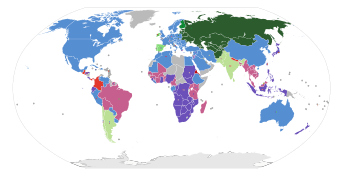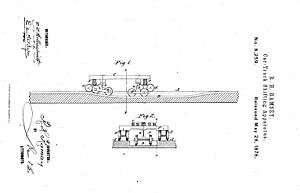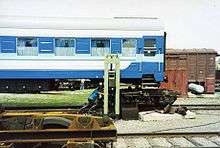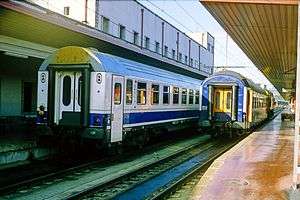Bogie exchange
| Track gauge | ||||||||||||||||||||||||||||||||||||||||||||||||||||||||||||||||||||||||||||||||||||||||
|---|---|---|---|---|---|---|---|---|---|---|---|---|---|---|---|---|---|---|---|---|---|---|---|---|---|---|---|---|---|---|---|---|---|---|---|---|---|---|---|---|---|---|---|---|---|---|---|---|---|---|---|---|---|---|---|---|---|---|---|---|---|---|---|---|---|---|---|---|---|---|---|---|---|---|---|---|---|---|---|---|---|---|---|---|---|---|---|---|
| By transport mode | ||||||||||||||||||||||||||||||||||||||||||||||||||||||||||||||||||||||||||||||||||||||||
|
Tram · Rapid transit Miniature · Scale model |
||||||||||||||||||||||||||||||||||||||||||||||||||||||||||||||||||||||||||||||||||||||||
| By size (list) | ||||||||||||||||||||||||||||||||||||||||||||||||||||||||||||||||||||||||||||||||||||||||
|
||||||||||||||||||||||||||||||||||||||||||||||||||||||||||||||||||||||||||||||||||||||||
| Change of gauge | ||||||||||||||||||||||||||||||||||||||||||||||||||||||||||||||||||||||||||||||||||||||||
|
Break-of-gauge · Dual gauge · Conversion (list) · Bogie exchange · Variable gauge |
||||||||||||||||||||||||||||||||||||||||||||||||||||||||||||||||||||||||||||||||||||||||
| By location | ||||||||||||||||||||||||||||||||||||||||||||||||||||||||||||||||||||||||||||||||||||||||
|
North America · South America · Europe · Australia  |
||||||||||||||||||||||||||||||||||||||||||||||||||||||||||||||||||||||||||||||||||||||||

Bogie exchange is a system for operating railway wagons on two or more gauges to overcome difference in the track gauge. To perform a bogie exchange, a car is converted from one gauge to another by removing the bogies or trucks (the chassis containing the wheels and axles of the car), and installing a new bogie with differently spaced wheels. It is generally limited to wagons and carriages, though diesel locomotives can be exchanged if enough time is available.


Wagons and carriages
Bogie wagons can have their gauge changed by lifting them off one set of bogies and putting them back down again on another set of bogies. The pin that centres the bogies and the hoses and fittings for the brakes must be compatible. A generous supply of bogies of each gauge is needed to accommodate the ebb and flow of traffic. The bogies and wagons also need to have standardized hooks, etc., where they may be efficiently lifted. The two wheel sets on four-wheel wagons can be changed as well if the wagon has been designed accordingly.
Engines
Steam
Steam engines can be designed for more than one gauge, by having, for example, reversible wheel hubs that suit two alternative gauges. This was done in the 1930s and beyond in Victoria for possible gauge conversion, though no engines were ever converted in this manner other than one heritage engine (R766). Some 1,000 mm (3 ft 3 3⁄8 in) metre gauge Garratt locomotives of East Africa were designed for easy conversion to 3 ft 6 in (1,067 mm) gauge, though again none ever was.
In 1944, the LMS re-gauged a pair of "Jinty" 0-6-0 tank locomotives - originally built to UK 4 ft 8 1⁄2 in (1,435 mm) standard gauge - for use on its 5 ft 3 in (1,600 mm) gauge Northern Counties Committee (NCC) lines in Northern Ireland; re-designated as Class Y, they largely undertook shunting work on dockyard lines in Belfast. The re-gauging was performed by simply reversing the wheel centres so that the spokes dished outwards.
In the southern United States, some steam locomotives built by Baldwin were designed for easy conversion from 5 ft (1,524 mm) to 4 ft 8 1⁄2 in (1,435 mm) standard gauge.
Diesel
Diesel locomotives have bogies like wagons and carriages, only with more cables for the traction motors and take a little longer to convert. In Australia, some classes of diesel locomotives are regularly gauge-converted to suit traffic requirements on the 1,435 mm (4 ft 8 1⁄2 in), 1,600 mm (5 ft 3 in), and 1,067 mm (3 ft 6 in) networks.
Since the 1,067 mm (3 ft 6 in) networks are not all connected to each other, being separated by deserts or lines of other gauges, they are bogie-exchanged or piggybacked on road or rail vehicles when transferred between these networks.
Raising or lowering
Raise
The simplest way to carry out bogie exchange is to lift the wagons off the bogies and replace them back on new bogies. This may require the wagons in a train to be uncoupled, and continuous brakes disconnected. As the bogies are swung out of the way, they sway, which wastes time settling them down.
Lower
Another way of carrying out bogie exchange is to lower the bogies onto a trolley in a pit, after which the trolleys are rolled out of the way and others return. This keeps the train couplings and continuous brakes connected. In addition, the bogies never need leave a solid surface, so they can be wheeled in and out more quickly. This method was used at Dry Creek railway station, Adelaide.[1]
International
Australia
Between 1961 and 1995, Australia had five bogie exchange centres, which opened and closed as gauge conversion work proceeded. The gauges served were 1,435 mm (4 ft 8 1⁄2 in) and 1,600 mm (5 ft 3 in), though the 1,067 mm (3 ft 6 in) Queensland did acquire 100 bogie-exchange compatible QLX wagons just in case. All the wagons involved had wagon codes ending in "X", such as VLX.
The centres were:
- Dynon, Melbourne, Victoria
- Wodonga near Albury on state border.
- Port Pirie, South Australia [2]
- Peterborough, South Australia
- Dry Creek, Adelaide, South Australia - the youngest and most modern[3][4][5]
The busiest facility was that at Dynon, in a typical year (1981–82), 24,110 wagons were bogie exchanged, an average of 66 per day. This was done by one shift of 18 men, compared with the 100 men required if the same amount of freight were transferred wagon to wagon.[6]
Belarus

- Brest, Belarus – between 1,520 mm (4 ft 11 27⁄32 in) and 1,435 mm (4 ft 8 1⁄2 in) at the border to Poland
Bolivia
Bogie exchange was used between 2 ft 6 in (762 mm) and 1,000 mm (3 ft 3 3⁄8 in) gauge on the Ferrocarril de Antofagasta a Bolivia Railway.
Canada
- Between 1,435 mm (4 ft 8 1⁄2 in) standard gauge and the 3 ft 6 in (1,067 mm) of the former Newfoundland Railway (Terra Transport) at Port aux Basques
China
A bogie exchange station exists at the Chinese border to Mongolia. Both the Moscow-Beijing passenger train (Trans-Siberian) and freight trains get their bogies exchanged. Mongolia has Russian gauge 1,520 mm (4 ft 11 27⁄32 in), China has 1,435 mm (4 ft 8 1⁄2 in). Also, a bogie exchange station was placed farther east at the Russian–Chinese border crossing at Zabaykalsk/Manzhouli.
Finland
A bogie exchange station exists in the Port of Turku with a short stretch of 1,435 mm (4 ft 8 1⁄2 in) gauge railway. Freight cars get their bogies exchanged. SeaRail train ferries go from Germany and Sweden. They carry no passenger trains, and passengers must walk by foot to Turku Harbour railway station opposite the ferry terminals. Finland has 1,524 mm (5 ft) broad gauge.
Germany
A bogie exchange station in the port of Mukran serves train ferries that go to and from Russia, Latvia, and Lithuania, which have 1,520 mm (4 ft 11 27⁄32 in) broad gauge.
Iran








Kazakhstan


Moldova
North Korea
- Tumangan, North Korea – between 1,435 mm (4 ft 8 1⁄2 in) and 1,520 mm (4 ft 11 27⁄32 in) (Russian gauge) at the border to Russia.
The bogies of the direct sleeping car Moscow – Pyongyang, which runs twice monthly, are exchanged there. [7]
Peru
- Between 1,435 mm (4 ft 8 1⁄2 in) standard gauge and 3 ft (914 mm) on the Ferrocarril Central Andino, including locomotives
Romania






Russia









Spain

- At Irun, between 1,435 mm (4 ft 8 1⁄2 in) and 1,668 mm (5 ft 5 21⁄32 in) (Iberian gauge)
- At Portbou, between 1,435 mm (4 ft 8 1⁄2 in) and 1,668 mm (5 ft 5 21⁄32 in)
Tunisia
- Between 1,435 mm (4 ft 8 1⁄2 in) standard gauge and 1,000 mm (3 ft 3 3⁄8 in) metre gauge, including locomotives
Ukraine







Transfer time
Bogie exchange conversion times were:
Variable gauge axles
Variable-gauge axles in an automatic track gauge changeover system (ATGCS) is a newer and faster development than bogie exchange. The SUW 2000 ATGCS requires a changeover track about 20 m long, with a shed if snow is around compared to a small marshalling yard required by bogie exchange.
Axle exchange
An alternative to variable gauge axles and bogie exchange is axle exchange.
See also
References
- ↑ Catch Point - November 2007 - p35 - picture of lowering method
- ↑ Australia. Bureau of Transport Economics (1 January 1977). "A study of Port Pirie bogie exchange / Bureau of Transport Economics". Australian Government Publishing Service. Retrieved 13 March 2017 – via National Library of Australia.
- ↑ http://www.trainweb.org/mystation/gauge1.txt
- ↑ Ian Patterson & Partners Archived July 18, 2008, at the Wayback Machine.
- ↑ Centre, Australian Science and Technology Heritage. "Technology in Australia 1788-1988, Chapter 7, page 477". UniMelb.edu.au. Retrieved 13 March 2017.
- ↑ Lee, Robert (2007). The Railways of Victoria 1854-2004. Melbourne University Publishing Ltd. p. 224. ISBN 978-0-522-85134-2.
- ↑ Helmut (9 March 2013). "36 hours in North Korea without a guide..." Vienna-Pyongyang.Blogspot.com. Retrieved 13 March 2017.
- ↑ Сахалинская узкоколейная железная дорога (The narrow-gauge railways of Sakhalin) (in Russian)
- ↑ "Train timetable". RW.by. Retrieved 13 March 2017.
External links

- "TRANSFER OF GAUGE". Sunday Times (Perth) (230). Western Australia. 8 June 1902. p. 1 (THE SUNDAY TIMES SUPPLEMENT). Retrieved 18 May 2017 – via National Library of Australia.
